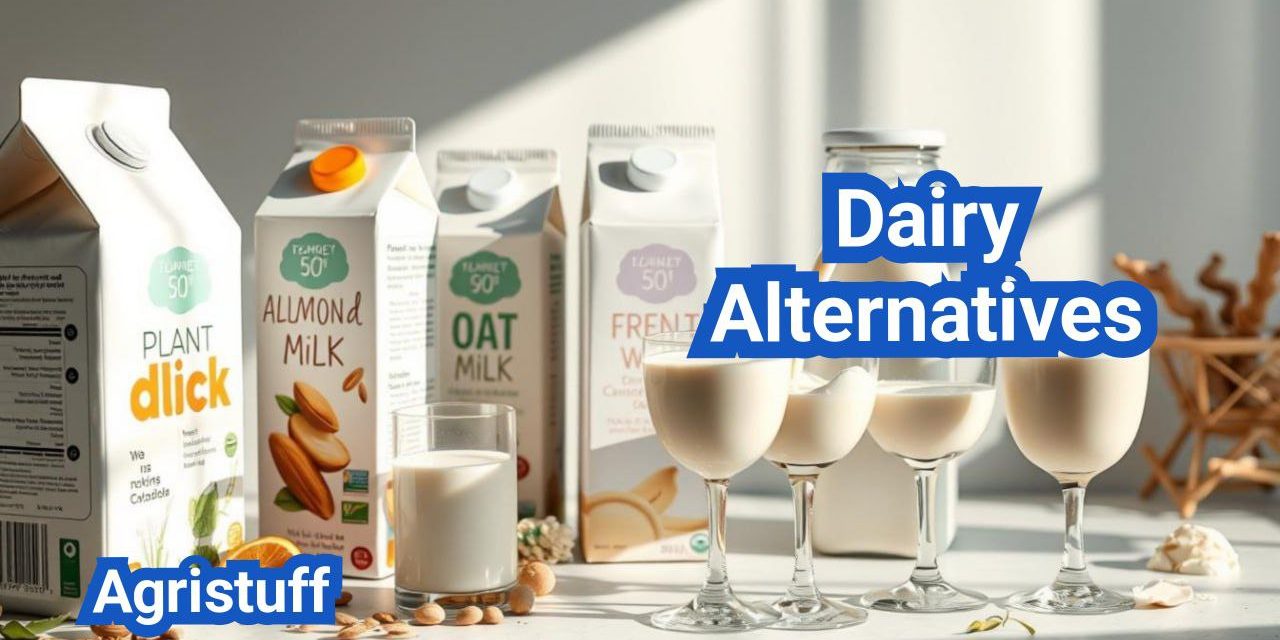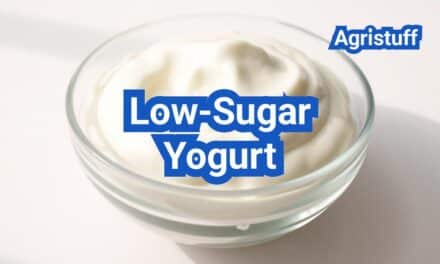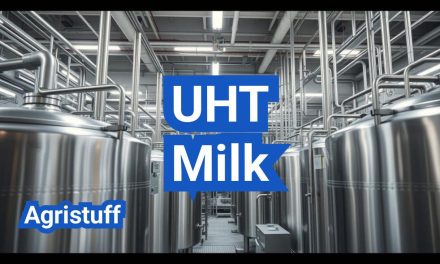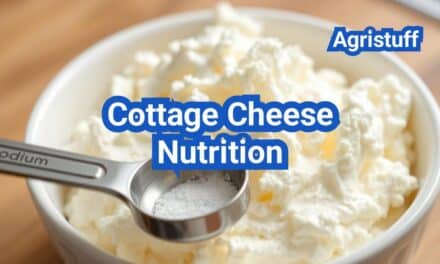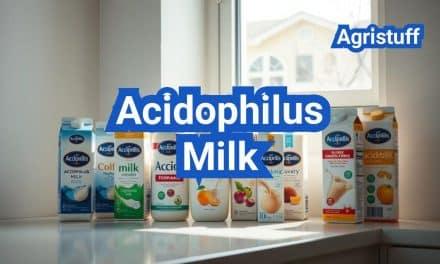The rise of plant-based milks as dairy alternatives has been significant, offering consumers a variety of options such as oat, almond, soy, and coconut milk.
These dairy alternatives cater to different nutritional needs and preferences, including those with lactose intolerance. Plant-based milks provide a range of nutritional benefits, from lower calories to enriched calcium content.
As consumers become more health-conscious, understanding the nutritional value and taste of these alternatives compared to traditional dairy milk is crucial.
Key Takeaways
- Plant-based milks offer a variety of nutritional benefits.
- Oat, almond, soy, and coconut milk are popular dairy alternatives.
- These alternatives cater to different dietary needs, including lactose intolerance.
- Nutritional content varies significantly among different plant-based milks.
- Comparing plant-based milks to traditional dairy milk is essential for informed dietary choices.
The Rise of Dairy Alternatives in Modern Diets
The dairy alternative market is witnessing a significant surge due to increasing consumer awareness about lactose intolerance and environmental sustainability. As a result, there’s been a notable shift towards plant-based diets, with dairy alternatives becoming increasingly popular.
What Qualifies as a Dairy Alternative
Dairy alternatives are products that mimic the taste, texture, and nutritional profile of dairy products but are derived from plant sources. These include milks made from almonds, soy, oats, and coconuts, as well as vegan cheeses and yogurts.
Key Characteristics of Dairy Alternatives:
- Derived from plant sources
- Mimic dairy products in taste and texture
- Often fortified with calcium and vitamins
- Suitable for those with lactose intolerance or dairy allergies
The Growing Market for Plant-Based Options
The market for dairy alternatives is expanding rapidly, driven by consumer demand for vegan and lactose-free products. This growth is reflected in the increasing availability of dairy alternatives in supermarkets and online.
| Product | Key Ingredients | Nutritional Highlights |
|---|---|---|
| Soy Milk | Soybeans, water | High in protein, often fortified with calcium |
| Almond Milk | Almonds, water | Low in calories, rich in vitamins |
| Oat Milk | Oats, water | Rich in fiber, often fortified with vitamins |
Common Reasons People Choose Non-Dairy Products
Consumers choose dairy alternatives for various reasons, including lactose intolerance, dietary preferences, and environmental concerns.
Some of the most common reasons include:
- Lactose intolerance or dairy allergies
- Preference for vegan or vegetarian diets
- Concerns about the environmental impact of dairy farming
- Dietary restrictions or preferences for lower calorie or fat content
By understanding these factors, consumers can make informed choices about their dairy consumption, whether they choose traditional dairy or opt for dairy alternatives.
Nutritional Profile: Traditional Dairy Products

Understanding the nutritional profile of traditional dairy products is crucial for making informed dietary choices. Dairy products, including cow’s milk, cheese, yogurt, butter, and cream, have been staples in many diets around the world.
Essential Nutrients in Cow’s Milk
Cow’s milk is a rich source of several essential nutrients. It is particularly known for its high content of calcium, which is vital for bone health. Additionally, cow’s milk contains protein, vitamin D, and potassium, making it a nutritious beverage.
The nutritional benefits of cow’s milk can be attributed to its composition. For instance, it contains a balanced mix of proteins, including casein and whey protein, which are important for muscle repair and growth.
Health Benefits of Cheese and Yogurt
Cheese and yogurt are dairy products that offer additional health benefits due to their probiotic content. Probiotics are beneficial bacteria that can aid in digestion and support gut health. Yogurt, in particular, is known for its live cultures, which can enhance digestive health.
Cheese is also a good source of calcium and protein. However, it’s essential to consume it in moderation due to its high calorie and fat content. Some types of cheese, like feta and parmesan, are also rich in probiotics.
Butter and Cream: Nutritional Considerations
Butter and cream are dairy products high in fat. While they can be part of a healthy diet when consumed in moderation, it’s crucial to be aware of their nutritional content. Butter is a source of vitamin A and vitamin E, but it is also high in saturated fats.
Cream, on the other hand, is rich in calories and fat but can be used to add creaminess to dishes. It’s also a source of fat-soluble vitamins. When using cream, it’s advisable to opt for lower-fat versions when possible.
Plant-Based Milk Alternatives: Complete Nutrition Guide
Different plant-based milks offer unique nutritional profiles, catering to various dietary needs. As consumers increasingly turn to plant-based diets, understanding the nutritional value of these milks is crucial for making informed choices.
Soy Milk: Protein Content and Amino Acid Profile
Soy milk is a popular plant-based milk alternative, known for its high protein content. It contains all nine essential amino acids, making it a complete protein source. One cup of soy milk provides approximately 8-10 grams of protein, comparable to cow’s milk. Soy milk is also often fortified with calcium, vitamin D, and vitamin B12, enhancing its nutritional profile.
Almond Milk: Calcium Content and Fortification
Almond milk is a low-calorie alternative that is naturally rich in vitamins. Many brands fortify almond milk with calcium and vitamin D, making it a good option for those seeking dairy-free sources of these nutrients. However, it’s essential to check the labels, as the level of fortification can vary significantly between brands.
Oat Milk: Calories, Protein, and Fiber Analysis
Oat milk has gained popularity due to its creamy texture and environmental benefits. It is naturally free from common allergens like nuts, making it a safe choice for many consumers. Oat milk’s nutritional content varies by brand, but it generally contains around 2-3 grams of protein per cup. Some brands enrich oat milk with fiber, enhancing its digestive benefits.
Coconut, Rice, and Hemp Milk: Unique Nutritional Benefits
Coconut milk is rich in healthy fats, particularly medium-chain triglycerides (MCTs), which have been linked to various health benefits. Rice milk is hypoallergenic and easy to digest, although it tends to be lower in protein. Hemp milk, made from hemp seeds, is a good source of omega-3 fatty acids and contains a balanced amino acid profile.
| Milk Type | Protein Content (g/cup) | Calcium Content (%DV) | Fortification |
|---|---|---|---|
| Soy Milk | 8-10 | 30% | Vitamin D, B12 |
| Almond Milk | 1-2 | 45% | Calcium, Vitamin D |
| Oat Milk | 2-3 | 35% | Fiber, Vitamins |
| Coconut Milk | 1-2 | 5% | MCTs |
| Rice Milk | 1 | 30% | Vitamin D |
| Hemp Milk | 3-5 | 20% | Omega-3 |
How to Choose the Best Dairy Alternatives for Your Needs

Selecting the right dairy alternatives requires a thoughtful approach, considering nutritional needs, label scrutiny, and the choice between unsweetened and sweetened options. With the vast array of plant-based milks and dairy-free products available, making an informed decision can be challenging.
Identifying Your Nutritional Priorities
When choosing dairy alternatives, it’s crucial to first identify your nutritional priorities. Are you looking for a product high in protein, or are you more concerned with calorie intake? Different dairy alternatives offer varying nutritional profiles. For instance, soy milk is known for its high protein content, while almond milk is often lower in calories.
| Dairy Alternative | Protein Content (g) | Calories |
|---|---|---|
| Soy Milk | 8-10 | 80-100 |
| Almond Milk | 1-2 | 30-60 |
| Oat Milk | 2-3 | 35-60 |
Reading Labels: Fortification and Added Ingredients
Reading labels is a critical step in choosing the best dairy alternatives. Look for products that are fortified with calcium and vitamin D, as these nutrients are essential for bone health. Be mindful of added ingredients such as thickeners, flavorings, and sweeteners. Some products may contain unwanted additives, so it’s essential to choose options that align with your dietary preferences.
“The key to making informed choices is to read labels carefully and understand what you’re consuming.” – Nutrition Expert
Unsweetened vs. Sweetened Varieties
Another important consideration is whether to choose unsweetened or sweetened dairy alternatives. Unsweetened varieties are ideal for those monitoring their sugar intake, while sweetened options may be preferred by those looking for a sweeter taste. Be aware that some sweetened products may contain artificial sweeteners, so it’s crucial to check the ingredient list.
Organic and Non-GMO Considerations
For some consumers, the decision to choose organic or non-GMO dairy alternatives is important. Organic products are made without synthetic pesticides or fertilizers, while non-GMO products ensure that the ingredients have not been genetically modified. While these factors may influence your decision, it’s also essential to consider the nutritional content and label information.
By considering your nutritional priorities, reading labels carefully, and making informed choices between unsweetened and sweetened varieties, you can select the best dairy alternatives for your needs. Whether you opt for organic, non-GMO, or fortified products, the key is to make choices that align with your dietary goals and preferences.
Dairy Alternatives for Cheese Lovers: Taste and Texture Guide
Dairy alternatives for cheese are revolutionizing the way we enjoy this beloved food group. With a variety of plant-based options available, consumers can now indulge in their favorite cheeses without the dairy.
Plant-Based Hard Cheese Substitutes
Plant-based hard cheese substitutes have become increasingly popular, offering a similar taste and texture to traditional hard cheeses like cheddar and parmesan. These alternatives are often made from nuts, soy, or vegetable oils.
- Nut-based cheeses: Made from cashews or almonds, these cheeses can be aged to develop a rich flavor.
- Soy-based cheeses: Soy protein is used to create a cheese-like texture, often fortified with calcium and vitamins.
- Vegetable oil-based cheeses: These cheeses use coconut oil or other vegetable oils to replicate the melt and stretch of dairy cheese.
Vegan Soft Cheese and Cream Cheese Options
Vegan soft cheese and cream cheese alternatives are perfect for spreads, dips, and baking. They are typically made from plant-based ingredients such as tofu, nuts, or soy.
- Cream cheese alternatives: Made from cashew cream or tofu, these can be flavored with herbs and spices.
- Brie and feta alternatives: Soft cheeses that mimic the taste and texture of their dairy counterparts, often using nuts or soy.
How to Make Dairy-Free Cheese at Home
Making dairy-free cheese at home is a fun and rewarding process. It allows you to control the ingredients and customize the flavors to your liking.
- Basic ingredients: Nuts, seeds, soy, and vegetable oils are common bases.
- Simple recipe: Blend your base with lemon juice, salt, and nutritional yeast, then ferment or chill until set.
By exploring these dairy alternatives for cheese, you can enjoy the taste and texture of cheese without the need for dairy products.
Yogurt Alternatives: Probiotic Content and Taste Comparison

With the growing interest in dairy-free products, yogurt alternatives made from various plant-based ingredients have emerged, offering diverse probiotic profiles and taste experiences. These alternatives cater to individuals with dietary restrictions, preferences, or intolerances, providing a range of options that traditional yogurt cannot.
Coconut and Almond-Based Yogurts
Coconut and almond-based yogurts are two popular dairy-free alternatives. Coconut yogurt is known for its rich, creamy texture and high probiotic content. It is often fortified with additional probiotics to enhance its digestive benefits. Almond yogurt, on the other hand, is lower in calories and rich in vitamins. Both options are available in various flavors, making them versatile choices for consumers.
Key Benefits:
- Coconut yogurt: High in probiotics, creamy texture
- Almond yogurt: Low in calories, rich in vitamins
Soy Yogurt: The Protein-Rich Option
Soy yogurt is a protein-rich alternative that is often compared to traditional yogurt in terms of nutritional content. It is an excellent source of protein and is frequently fortified with calcium and vitamin D. Soy yogurt’s probiotic content supports gut health, making it a popular choice among those seeking dairy-free options without compromising on nutrition.
Why Choose Soy Yogurt? It offers a high protein content, is often fortified with essential nutrients, and supports digestive health.
Oat Yogurt: Texture and Flavor Profile
Oat yogurt has gained popularity due to its smooth texture and neutral flavor profile, making it an excellent base for various recipes. It is naturally free from common allergens like nuts and dairy, making it a safe choice for many consumers. Oat yogurt is also a good source of fiber, contributing to its nutritional appeal.
How to Make Homemade Plant-Based Yogurt
Making homemade plant-based yogurt is a straightforward process that allows for customization in terms of ingredients and flavors. To start, choose a plant-based milk (such as coconut, almond, soy, or oat milk) and a probiotic source (like probiotic powder or capsules). Heat the milk to a suitable temperature, add the probiotic, and incubate it at a warm temperature until it thickens. Finally, chill the yogurt in the refrigerator before consuming.
Steps to Make Homemade Yogurt:
- Choose a plant-based milk
- Add a probiotic source
- Incubate the mixture
- Chill before serving
By making yogurt at home, consumers can control the ingredients, ensuring that their yogurt is free from unwanted additives and tailored to their taste preferences.
Butter and Cream Substitutes: Cooking and Baking Guide

The world of dairy alternatives has expanded, offering various butter and cream substitutes for cooking and baking. As consumers increasingly adopt plant-based diets, the demand for high-quality dairy-free alternatives has driven innovation in this sector.
Plant-Based Butter Alternatives for Spreading
Plant-based butter alternatives have become a staple in many kitchens. Made from a variety of ingredients such as almond milk, coconut oil, and olive oil, these butters offer a dairy-free option for spreading on toast, baking, and cooking.
- Erdnussbutter made from peanuts
- Coconut oil-based butters for a rich flavor
- Olive oil-based butters for a healthier option
When choosing a plant-based butter, consider the ingredient list and nutritional content. Many brands fortify their products with vitamins and minerals, enhancing their nutritional profile.
Dairy-Free Options for Baking
Baking without dairy requires careful substitution to achieve the desired texture and flavor. Dairy-free milks, vegan butters, and alternative eggs can be used in various combinations to replace traditional dairy products.
| Dairy Product | Dairy-Free Alternative |
|---|---|
| Butter | Vegan butter or coconut oil |
| Milk | Almond milk, soy milk, or oat milk |
| Eggs | Flax eggs or chia eggs |
Heavy Cream and Half-and-Half Substitutes
For creamy sauces and soups, heavy cream and half-and-half are commonly used. However, dairy-free alternatives can achieve similar richness and texture.
- Coconut cream: Chill a can of full-fat coconut milk, then scoop out the solid cream for use in recipes.
- Cashew cream: Soak cashews in water, blend with water until smooth, and use as a creamy base.
- Soy cream or oat cream: Commercially available options that mimic the texture of dairy cream.
Oil-Based Alternatives for Different Cooking Methods
Different cooking methods require different types of oil or fat. For sautéing, baking, or making dressings, various oil-based alternatives can be used.
- Avocado oil for high-heat cooking
- Olive oil for dressings and low-heat cooking
- Coconut oil for baking and adding flavor
Dairy Alternatives for Special Populations

The quest for appropriate dairy alternatives is particularly significant for special populations, including infants, pregnant women, and older adults. Different life stages require tailored nutritional approaches to ensure optimal health.
Safe Options for Babies: Formula and First Foods
For infants, dairy alternatives are often considered for formula and first foods. It’s crucial to select options that are nutritionally adequate and safe. Plant-based formulas are designed to mimic the nutritional profile of breast milk or traditional dairy-based formulas.
When introducing dairy alternatives to infants, parents should consult with a pediatrician to determine the best option. Some babies may have allergies or intolerances that require special consideration.
Nutritious Choices for Toddlers and Children
Toddlers and children have unique nutritional needs that must be met through their diet. Dairy alternatives can be a healthy choice if they are fortified with essential nutrients like calcium and vitamin D.
Parents can offer a variety of dairy alternatives, such as fortified plant-based milks, to ensure their children receive a balanced intake of necessary nutrients.
Dairy Alternatives During Pregnancy and Breastfeeding
During pregnancy and breastfeeding, women have increased nutritional needs. Dairy alternatives can be a valuable part of their diet if chosen wisely. It’s essential to select options that are rich in calcium, vitamin D, and protein.
Breastfeeding women can benefit from dairy alternatives that are fortified with omega-3 fatty acids and other essential nutrients.
Considerations for Older Adults
Older adults may require dairy alternatives due to lactose intolerance or dietary preferences. They should focus on options that are high in calcium and vitamin D to support bone health.
| Life Stage | Nutritional Needs | Dairy Alternatives |
|---|---|---|
| Infants | Protein, Calcium, Vitamin D | Plant-based formulas, Fortified milks |
| Toddlers/Children | Calcium, Vitamin D, Protein | Fortified plant-based milks, Yogurt alternatives |
| Pregnant/Breastfeeding Women | Calcium, Vitamin D, Omega-3 | Fortified milks, Yogurt alternatives, Omega-3 enriched products |
| Older Adults | Calcium, Vitamin D, Protein | Fortified milks, Yogurt alternatives, Calcium supplements |
Managing Lactose Intolerance with Dairy Alternatives

Lactose intolerance is a common condition that can be managed effectively with the right dietary choices, including dairy alternatives. Individuals with lactose intolerance lack the enzyme lactase, which is necessary for breaking down lactose, a sugar found in milk and other dairy products. This condition can lead to uncomfortable symptoms such as bloating, gas, and diarrhea after consuming lactose-containing foods.
Understanding Lactose Intolerance vs. Milk Allergy
It’s crucial to differentiate between lactose intolerance and a milk allergy. While lactose intolerance is a digestive issue related to the inability to process lactose, a milk allergy is an immune system reaction to one of the proteins in milk (casein or whey). Symptoms of a milk allergy can range from mild hives to life-threatening anaphylaxis. Understanding this distinction is key to managing dietary choices appropriately.
Best Plant-Based Options for Digestive Comfort
Plant-based milk alternatives are an excellent choice for those with lactose intolerance. Options such as almond milk, soy milk, oat milk, and coconut milk are naturally lactose-free and can provide essential nutrients. For instance, almond milk is often fortified with calcium and vitamins, making it a nutritious substitute for cow’s milk. When selecting a plant-based milk, it’s essential to read labels to ensure they are fortified with necessary nutrients.
Lactose-Free Dairy Products as Alternatives
For those who still wish to consume dairy products, lactose-free dairy options are available. These products have had the lactase enzyme added to break down the lactose, making them easier to digest. Lactose-free milk, cheese, and yogurt are widely available in most supermarkets, providing a convenient alternative for individuals with lactose intolerance.
Reading Labels for Hidden Lactose
Even when opting for dairy alternatives, it’s crucial to read labels carefully to avoid hidden sources of lactose. Some products, such as processed foods, medications, and even certain types of bread, can contain lactose. Being aware of the various names for lactose on ingredient labels can help individuals with lactose intolerance make informed dietary choices.
By choosing the right dairy alternatives and being mindful of hidden lactose sources, individuals with lactose intolerance can enjoy a varied and nutritious diet without the discomfort associated with their condition.
Ensuring Adequate Calcium and Vitamin Intake Without Dairy

Ensuring sufficient calcium and vitamin intake is crucial for those who choose dairy-free options. A well-planned dairy-free diet can provide all the necessary nutrients for good health, but it requires careful consideration of various food sources and products.
Plant-Based Calcium Sources
Calcium is essential for bone health, and there are numerous plant-based sources that can provide adequate amounts. Some of the richest sources include:
- Fortified plant-based milk
- Leafy greens like kale and broccoli
- Almonds and sesame seeds
- Tofu and other soy products
These foods can be easily incorporated into daily meals to ensure sufficient calcium intake.
Vitamin D, B12, and Iodine in Dairy-Free Diets
Besides calcium, vitamins D, B12, and iodine are crucial nutrients often found in dairy products. Vitamin D is important for bone health and immune function, while vitamin B12 plays a key role in energy production and nerve function. Iodine is essential for thyroid function.
Plant-based sources and fortified products can help meet these nutritional needs:
| Nutrient | Plant-Based Sources | Fortified Products |
|---|---|---|
| Vitamin D | Mushrooms, sunlight exposure | Plant-based milk, cereals |
| Vitamin B12 | Some nutritional yeast, fortified cereals | Vegan B12 supplements, fortified plant milk |
| Iodine | Iodized salt, seaweed | Some plant-based milk and bread |
Fortified Products vs. Natural Sources
Both fortified products and natural sources play a vital role in a dairy-free diet. While natural sources provide a range of nutrients, fortified products can help fill any nutritional gaps.
For example, fortified plant milk can provide calcium, vitamin D, and vitamin B12. Choosing a variety of both fortified products and natural sources ensures a balanced diet.
Supplement Considerations for Dairy-Free Diets
For some individuals, supplements may be necessary to ensure adequate intake of certain nutrients. It’s essential to consult with a healthcare provider before starting any supplement regimen.
Common supplements for dairy-free diets include:
- Calcium supplements
- Vitamin D supplements
- Vitamin B12 supplements
- Iodine supplements
A healthcare professional can help determine the best course of action based on individual nutritional needs.
Environmental Impact: Dairy vs. Plant-Based Alternatives

The environmental implications of choosing between dairy and plant-based milk alternatives are multifaceted and warrant a closer examination. As the world grapples with climate change and resource depletion, understanding the ecological footprint of our dietary choices is crucial.
Water Usage and Carbon Footprint Comparison
The production of dairy milk requires significantly more water than most plant-based alternatives. For instance, it takes approximately 1,000 liters of water to produce just one liter of milk, whereas almond milk requires about 74 liters per liter. The carbon footprint of dairy milk is also substantial, with dairy farming contributing to greenhouse gas emissions through the release of methane and nitrous oxide.
In contrast, plant-based milks generally have a lower carbon footprint, although this can vary depending on the crop used and the production methods employed. For example, almond milk tends to have a lower carbon footprint than dairy milk, but the water usage for almond cultivation can be significant.
| Milk Type | Water Usage (liters/liter) | Carbon Footprint (kg CO2/liter) |
|---|---|---|
| Dairy Milk | 1,000 | 3.1 |
| Almond Milk | 74 | 0.7 |
| Oat Milk | 48 | 0.3 |
| Soy Milk | 300 | 1.0 |
Land Use and Biodiversity Considerations
Dairy farming requires large areas of land for grazing and feed crop production, which can lead to deforestation and habitat loss. This not only affects biodiversity but also contributes to climate change. Plant-based milk alternatives, on the other hand, generally require less land, although the cultivation of certain crops like almonds can still have environmental impacts.
To mitigate these effects, it’s essential to choose plant-based milks that are sustainably sourced and produced. Looking for certifications like Rainforest Alliance or Fair Trade can help ensure that the products are made with consideration for the environment and local ecosystems.
Processing and Packaging Sustainability
The processing and packaging of both dairy and plant-based milks have environmental implications. Traditional dairy packaging often involves non-recyclable materials, while some plant-based milks are packaged in more sustainable formats, such as cartons or glass bottles. However, the production of these alternatives can still involve energy-intensive processes.
Consumers can make a difference by choosing products with minimal or biodegradable packaging and supporting companies that prioritize sustainability in their processing and distribution practices.
Making Environmentally Conscious Choices
When selecting between dairy and plant-based milk alternatives, consumers should consider not only the nutritional content but also the environmental impact. By choosing options with lower water usage, carbon footprint, and more sustainable packaging, individuals can contribute to a more environmentally friendly food system.
Ultimately, making informed choices requires a comprehensive understanding of the environmental implications of our dietary preferences. By opting for sustainably produced plant-based milks and supporting eco-friendly practices, consumers can help reduce the environmental footprint of their diets.
Practical Applications: Using Dairy Alternatives in Daily Life

From coffee to cooking, dairy alternatives offer versatility and nutrition. As more people adopt plant-based diets, understanding how to incorporate these alternatives into daily routines becomes increasingly important.
Best Milk Alternatives for Coffee and Frothing
When it comes to coffee, the right milk alternative can make all the difference. Oat milk and almond milk are popular choices due to their creamy texture and neutral flavor. For frothing, baristas often prefer oat milk because it creates a smooth, velvety foam. As noted by coffee aficionados, “The key to a great latte is not just the coffee, but the quality of the milk used.”
“A good milk alternative should enhance the flavor of your coffee without overpowering it.”
Cooking and Baking Substitution Guide
Dairy alternatives can be used in a variety of cooking and baking applications. When substituting dairy products, it’s essential to consider the recipe’s requirements. For instance, coconut milk adds richness to curries, while almond milk can be used in baked goods. A simple substitution guide can help navigate these choices.
- Replace cow’s milk 1:1 with almond milk or oat milk in most recipes.
- Use coconut milk for creamy sauces and soups.
- Choose vegan butter or margarine for baking.
Creating Creamy Sauces and Soups Without Dairy
Creating creamy sauces and soups without dairy is easier than ever with the right alternatives. Coconut cream and cashew cream are excellent substitutes for heavy cream. By blending soaked cashews with water, you can create a creamy base for soups and sauces. “The versatility of cashew cream is unmatched; it’s a game-changer for vegan cooking.”
Dairy-Free Options for Cheese Boards and Entertaining
Entertaining guests with dairy-free options can be just as impressive as traditional cheese boards. Vegan cheese alternatives have come a long way, offering a range of flavors and textures. Consider pairing these with crackers, fruits, and nuts for a delightful spread. As one vegan chef notes, “Dairy-free doesn’t mean flavor-free; it’s about exploring new possibilities.”
Balancing Nutrition, Taste, and Lifestyle Choices
As we navigate the world of dairy alternatives, it’s clear that making informed choices is crucial. Balancing nutrition, taste, and lifestyle choices is key to adopting a diet that suits individual needs. Dairy alternatives offer a range of benefits, from catering to dietary restrictions to providing environmentally friendly options.
The nutritional profiles of plant-based milks, cheeses, yogurts, and other dairy alternatives vary widely. Understanding these differences is essential for ensuring adequate nutrition. Whether prioritizing protein content, calorie intake, or specific vitamins and minerals, there’s a dairy alternative to suit every requirement.
Taste and texture are also significant factors. With advancements in food technology, many dairy alternatives now closely mimic their traditional counterparts, making the transition smoother for those looking to reduce their dairy intake.
Lifestyle choices, including environmental concerns and dietary preferences, play a significant role in the decision-making process. By choosing dairy alternatives, individuals can contribute to a more sustainable food system while meeting their nutritional and culinary needs.
Ultimately, the shift towards dairy alternatives is about more than just substituting one product for another; it’s about embracing a lifestyle that prioritizes health, sustainability, and personal preference. By being mindful of the options available and their implications, individuals can make choices that align with their values and nutritional goals.
FAQ
What are dairy alternatives, and why are they becoming popular?
Dairy alternatives are plant-based substitutes for traditional dairy products, such as milk, cheese, and yogurt. They are becoming increasingly popular due to growing concerns about lactose intolerance, environmental sustainability, and animal welfare.
What are the most common types of plant-based milks available?
The most common types of plant-based milks are soy milk, almond milk, oat milk, coconut milk, rice milk, and hemp milk. Each has its unique nutritional profile and benefits.
Are plant-based milks nutritionally equivalent to cow’s milk?
While some plant-based milks are fortified to match the nutritional profile of cow’s milk, others may lack certain nutrients. It’s essential to read labels and choose options that meet your nutritional needs.
What are the benefits of choosing dairy alternatives for lactose intolerance?
Dairy alternatives can help alleviate symptoms of lactose intolerance, such as bloating and discomfort, by providing lactose-free options. They can also offer a range of nutritional benefits, including lower saturated fat content.
Can dairy alternatives provide adequate calcium and vitamin D?
Yes, many dairy alternatives are fortified with calcium and vitamin D, making them suitable substitutes for traditional dairy products. Additionally, some plant-based foods, such as leafy greens and fortified cereals, are naturally rich in these nutrients.
How do I choose the best dairy alternative for my needs?
To choose the best dairy alternative, consider your nutritional priorities, such as protein content, calorie count, and fortification. Read labels carefully, and opt for unsweetened and organic options when possible.
Are dairy alternatives suitable for all life stages, including babies and older adults?
Yes, dairy alternatives can be suitable for various life stages, including babies, toddlers, pregnant and breastfeeding women, and older adults. However, it’s crucial to consult with a healthcare professional or registered dietitian to ensure you’re meeting your nutritional needs.
Can I use dairy alternatives in cooking and baking?
Yes, dairy alternatives can be used in a variety of recipes, including cooking and baking. They can be substituted for traditional dairy products in many cases, but you may need to adjust the ratio or add additional ingredients to achieve the desired texture and flavor.
What are some environmentally friendly dairy alternatives?
Some dairy alternatives, such as oat milk and soy milk, have a lower environmental impact compared to traditional dairy farming. Choosing locally sourced, organic, and sustainably produced options can also help reduce your carbon footprint.
How can I ensure I’m getting enough vitamin B12 on a dairy-free diet?
Vitamin B12 is found primarily in animal products, so it’s essential to consume fortified plant-based milk, cereals, and meat substitutes or consider supplements to meet your daily needs.
Are there any dairy alternatives that are high in protein?
Yes, soy milk and soy yogurt are high in protein, making them excellent options for those looking to boost their protein intake. Other plant-based milks, such as pea milk and hemp milk, are also high in protein.
Can I make my own dairy alternatives at home?
Yes, you can make your own dairy alternatives at home, such as nut milks, oat milk, and yogurt. This can be a fun and cost-effective way to experiment with different flavors and textures.
Conclusion of: Dairy Alternatives
Introduction: why dairy alternatives are everywhere
Dairy alternatives are now a staple in U.S. supermarkets, fueled by lactose intolerance, vegan or flexitarian eating, sustainability concerns, and simple taste preferences; this guide compares dairy alternatives with real dairy so you can pick what matches your nutrition goals, recipes, and budget. USDA MyPlate: Dairy Group overview
What “counts” as dairy—and where dairy alternatives fit
Dairy alternatives are not all treated the same in U.S. dietary guidance: fortified soy beverage is considered most comparable and can count toward Dairy Group servings, while other dairy alternatives like almond, oat, rice, and coconut typically do not meet Dairy Group criteria even if they’re fortified. USDA MyPlate: Fortified soy counts as dairy
Labeling basics for dairy alternatives
To evaluate dairy alternatives consistently, read the Nutrition Facts label for protein per cup, calcium and vitamin D %DV, added sugars, and allergen statements; brand-to-brand differences are large, so the label is the fairest way to compare dairy alternatives with cow’s milk. FDA: How to use the Nutrition Facts label
Protein: the biggest gap between many dairy alternatives and milk
Dairy alternatives often provide less protein than cow’s milk (about 8 g per cup), with soy-based dairy alternatives usually closest and many almond or oat options offering far less; beyond grams, protein quality matters, and dairy proteins and soy rank high on internationally recognized digestibility scores. FAO report on dietary protein quality (DIAAS)
Calcium: fortification form affects dairy alternatives’ absorption
Many dairy alternatives are fortified to ~300 mg calcium per cup, but absorption can differ by compound; research shows calcium carbonate–fortified soy dairy alternatives can match milk for absorption, whereas tricalcium phosphate may be less bioavailable—so scan dairy alternatives for the fortification type. J Nutr: Calcium absorption from fortified soy “milk”
Vitamin D and B12: critical checks for dairy alternatives
Because vitamin D is commonly added to milk, and vitamin B12 occurs naturally in animal foods, people relying on dairy alternatives should confirm both nutrients are present via fortification—especially important for vegans choosing dairy alternatives as daily staples. NIH ODS: Vitamin B12 fact sheet
Iodine: a quiet shortfall in many dairy alternatives
Iodine supports thyroid function and is present in variable amounts in dairy; many dairy alternatives lack iodine fortification, so if you avoid dairy and choose dairy alternatives, plan for iodized salt or iodine-rich foods to avoid gaps. NIH ODS: Iodine fact sheet
Added sugars: choose unsweetened dairy alternatives
Flavored or sweetened dairy alternatives can sharply raise added sugar intake; for cardiometabolic health and weight management, favor “unsweetened” dairy alternatives and verify the grams of added sugars on the Nutrition Facts panel. FDA: Added sugars on the label
Lactose intolerance: where dairy alternatives shine
For people with lactose intolerance, dairy alternatives offer a lactose-free way to enjoy milk-like beverages; note that lactose-free dairy milk is another option if you prefer dairy, while dairy alternatives provide additional taste and nutrition choices. NIDDK: Lactose intolerance overview
Food allergies: dairy alternatives still demand caution
While dairy alternatives avoid milk proteins, many contain top allergens such as soy or tree nuts; always read the “Contains:” statements and ingredient lists on dairy alternatives if allergies are a concern. FDA: Food allergy basics
Kids and teens: how dairy alternatives can fit growth needs
Growing children need protein, calcium, vitamin D, and iodine; fortified soy dairy alternatives are generally the closest match to milk and the only plant-based option that “counts” toward Dairy Group servings, while other dairy alternatives can still be part of a balanced diet with careful planning. American Academy of Pediatrics: Cow’s milk alternatives
Environmental lens: dairy alternatives vs dairy milk
Life-cycle analyses show most dairy alternatives require less land and produce fewer greenhouse gas emissions per liter than dairy milk, though trade-offs exist (e.g., almond’s irrigation needs); choose dairy alternatives that align with both your nutrition and sustainability goals. Our World in Data: Environmental impacts of milks
Taste and texture: practical cooking with dairy alternatives
In coffee and culinary foam, dairy proteins stabilize microbubbles; among dairy alternatives, barista-style soy and oat often foam best, while almond and coconut dairy alternatives may thin batters or lend distinct flavors—test dairy alternatives in your own recipes to find the right fit. USDA MyPlate: Dairy & kitchen basics
Label-reading checklist for choosing dairy alternatives
Use this quick filter for dairy alternatives: 1) Protein closer to 6–8 g per cup; 2) Calcium ~20–30% DV (check fortification type); 3) Vitamin D and B12 present; 4) Iodine plan if not fortified; 5) “Unsweetened” to limit added sugars; 6) Allergen check for soy or nuts in dairy alternatives. FDA: Master the Nutrition Facts label
When soy-based dairy alternatives are the best match
If your priority is nutrient parity with milk, soy-based dairy alternatives are typically strongest—solid protein quality and content, commonly fortified with calcium and vitamin D, and recognized in U.S. guidance as comparable for Dairy Group servings. USDA MyPlate: Why fortified soy counts
When almond, oat, or coconut dairy alternatives win
If you prefer lighter body or specific flavors, almond or coconut dairy alternatives can be delightful in smoothies and curries, while oat dairy alternatives often deliver a creamy, neutral profile that many enjoy in cereal and lattes; just remember to prioritize unsweetened, fortified dairy alternatives. FDA: Checking added sugars in dairy alternatives
Budget and availability: smarter shopping for dairy alternatives
Store brands of dairy alternatives have grown rapidly and can match national labels in taste and fortification; compare unit prices and verify that store-brand dairy alternatives include calcium, vitamin D, and B12 if you’re using them as everyday substitutes. USDA MyPlate: Shop Simple
Culinary swaps: using dairy alternatives in common dishes
For creamy soups and mashed potatoes, soy-based dairy alternatives usually hold body; oat dairy alternatives add pleasant creaminess to coffee and porridge; almond dairy alternatives keep smoothies light—experiment with small batches to dial in texture and flavor. USDA MyPlate: Dairy in the kitchen
Special diets: vegan, low-FODMAP, and more with dairy alternatives
Vegans relying on dairy alternatives should confirm vitamin B12 and vitamin D fortification; people on low-FODMAP plans may prefer lactose-free dairy or specific dairy alternatives; in all cases, choose dairy alternatives that fill—not create—nutrient gaps. NIH ODS: B12 considerations with dairy alternatives
Infants and toddlers: safety notes for dairy alternatives
For infants under 12 months, neither cow’s milk nor dairy alternatives should replace breast milk or formula; after the first year, fortified soy dairy alternatives can be used in a balanced diet, but consult your pediatrician before relying on any dairy alternatives for toddlers. AAP: Guidance on milk alternatives
Bottom line decision tree for dairy alternatives
If you want the closest nutrition match to milk, pick fortified, unsweetened soy dairy alternatives; if foam and creaminess in coffee matter, try barista-style oat dairy alternatives; if lighter smoothies are your thing, almond dairy alternatives are popular; if sustainability is key, most dairy alternatives reduce footprint vs milk—always verify labels. FDA: Use labels to compare dairy alternatives
Final thought
Dairy alternatives don’t have to replace dairy completely—many Americans blend choices through the week; focus on your priorities (protein, calcium, vitamin D/B12, iodine, added sugars), choose fortified and unsweetened dairy alternatives, and let taste and budget guide the rest. USDA MyPlate: Build a balanced Dairy Group plan
Sources & References
USDA MyPlate: Dairy Group & fortified soy
FAO Expert Consultation on Dietary Protein Quality (DIAAS)
Zhao et al., 2005: Calcium absorption from fortified soy “milk”
FDA: Understanding the Nutrition Facts label
FDA: Added sugars on the Nutrition Facts label
FDA: Food allergies—what you need to know
Our World in Data: Environmental impacts of dairy and plant-based milks

